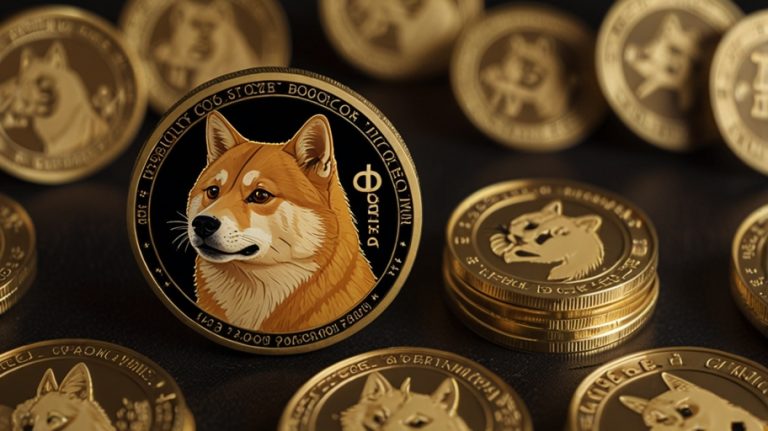The latest development in the world of cryptocurrencies is the resurgence of Dogecoin (DOGE), which has been able to recapture the interest of both cryptocurrency enthusiasts and investors. The memetic digital asset, which is presently sitting as the 8th most powerful cryptocurrency in the global market, has therefore exhibited a very commendable grasp of the market and growth, which once were too abstract for people who did not trust it. Many used to think of it as a mere joke! Not anymore.
It’s reached the normal but still a million-dollar level: The Dogecoin is priced on the exchange market at 0.2633 USD, resulting in an increase of 1.70% in relation to the last 24 hours. Simply said, the coin seems to be riding the wave upwards, thus pushing its market capitalization to be the third to Bitcoin. Bitcoin does not count.
The latest rise in Dogecoin’s value was&emdash; as noël&emdash; a big deal in trading activity. Trading volume however, could never miss aggrandizement alongside it–noticed especially the highest for any token for the last day that traded in the amount of $1.38 billion, this transaction increase must have looked even better by those who have been investing e-tokens for a while. The increase in trading activity also implies that, indeed, the enthusiasm has come back amongst both consumers and institutional investors.
With respect to the performance of Dogecoin in the immediate past, the proportion of volume to market cap is the most fascinating feature. It has now surged to 3.52% and it would be decreasing the number all day long. This figure represents a stable trade volume and liquidity of the coin a a whole, backing it widely as one household in the crypto universe.
Though Dogecoin is a wellspring from a funny take-off of Bitcoin, it surprisingly managed to be distinct within the crypto ecosystem. Its loyal community, who are also named the Doge Army, has been the main factor of its success, by boosting its take-up and keeping the project vibrant.
One of the most important reasons behind the popular appeal of Dogecoin is its limitless volume. For comparison, as an example, Bitcoin, and its predicament, is burning out all 21 million coins into the ecosystem, whilst Dogecoin doesn’t come with any such limitations. Up to this point in time, the model of inflation that it features has been the subject of various debates of the experts in the field.
Adherents are of the opinion that the absence of the maximum supply constitutes this altcoin advantage as it should not only be an investment instrument but also a medium of exchange for daily usage. However, critics of the legend hold reservations that the higher issuance capacity might imply a strengthening of the currency after a brief period of time.
Nevertheless, these concerns have not hindered Dogecoin from becoming the preferred digital currency for the new rich people from the filming and entertainment industries. Elon Musk, the mysterious genius of Tesla and SpaceX, has been a keen endorser of Dogecoin, through the creation of a buzz on Twitter about the cryptocurrency and even poking fun at his creator as “Dogefather”.
Overrating celebrity endorsements as the sole contributor to Dogecoin’s price is a mistake. Most of the time, every tweet or public statement released by Musk and other leading celebrities was very often connected with big price impacts, illustrating tech-savvy power to direct the cryptocurrency markets with the aid of social networks.
What’s even more impressive is the mainstream adoption that has been widely met by Dogecoin along with its meme moniker. There has been a considerable increase in the number of merchants and companies that have joined the ranks of those that have adopted DOGE as a form of payment, covering a spectrum of small independents to giants among entertainment and sports.
The Dogecoin Foundation, a non-profit organization committed to facilitating the development and promotion of cryptocurrency, has been working to expand its use cases and improve its core technology. Following a series of initiatives, they have managed to maximize the transaction execution speed and the coin has become more competitive against other popular cryptocurrencies due to the decrease in fees.
Moving forward the more mature cryptocurrency market will pose increased opportunities as well as difficulties also for Dogecoin. The ongoing discussions about environmental issues as a result of proof-of-work mining, which Dogecoin is using, have necessitated a rethinking of the form of consensus mechanism to be applied.
Besides, on the macro scale, government scrutiny on a broader scale is one of these that might as well bring neutral responses for some digital assets such as Dogecoin. As the governments globally are facing the challenge of managing the sector’s growth, the legal and regulatory frames for cryptocurrencies are still in a state of flux.
Although the hurdles might be countless, the Dogecoin community is still upbeat about the potential of their favorite cryptocurrency. The chip’s durability in the wake of market fluctuation and its capacity to stay among the top 10 cryptocurrencies by market cap have made it a force to be reckoned with.
Within the cryptocurrency market’s maturation process, Dogecoin’s attempt from a meme token to a new player in the digital asset sector acts as a proof to the cryptocurrency sector being unpredictable and frequently surprising. In the interim, the Doge army is still behind the “Shiba Inu”-inspired digital coin.












 Bitcoin
Bitcoin  Ethereum
Ethereum  Tether
Tether  XRP
XRP  Wrapped SOL
Wrapped SOL  USDC
USDC  Lido Staked Ether
Lido Staked Ether  TRON
TRON  Cardano
Cardano  Avalanche
Avalanche  Toncoin
Toncoin